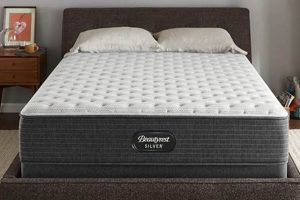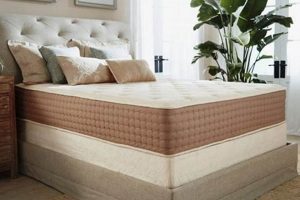The selection of a suitable sleep surface addition for individuals who primarily rest on their abdomen is a key factor in optimizing spinal alignment and mitigating pressure point discomfort. These individuals require a relatively firm yet cushioning layer that prevents excessive sinking of the midsection, thus maintaining a neutral spinal position. An example would be a dense memory foam or a supportive latex layer designed to offer both comfort and adequate support.
The significance of choosing the correct supplementary sleep surface for this sleep position lies in the potential for reducing back pain, neck strain, and morning stiffness. Historically, individuals sleeping on their stomach often experienced aggravated spinal issues due to inadequate support. The advent of specialized sleep surface additions designed for this posture represents a significant advancement in sleep technology and comfort.
The following sections will delve into the various materials, features, and considerations necessary for selecting an appropriate surface addition, including factors such as density, thickness, and material composition, which all contribute to optimal support and comfort for individuals who favor resting in a prone position.
Tips for Optimal Selection
This section provides guidance on identifying a supplementary sleep surface that aligns with the specific needs of individuals who primarily sleep on their stomachs. Careful consideration of these factors can significantly enhance comfort and promote spinal health.
Tip 1: Prioritize Density: Opt for a high-density material, such as dense memory foam or latex. A higher density provides greater support and prevents excessive sinking of the midsection, which is crucial for maintaining proper spinal alignment.
Tip 2: Consider Thickness Carefully: A thickness between two and four inches is generally recommended. This range offers a balance of cushioning and support, preventing both excessive sinking and an uncomfortably firm surface.
Tip 3: Evaluate Material Composition: Latex offers a naturally resilient and supportive option, while memory foam contours to the body’s shape. Consider the individual’s preference for responsiveness versus conforming support when selecting the material.
Tip 4: Assess Firmness Level: A medium-firm to firm surface is generally preferable. A softer surface can exacerbate spinal misalignment, while an overly firm surface may lack sufficient cushioning.
Tip 5: Examine Pressure Relief Capabilities: The supplementary sleep surface should effectively distribute weight to minimize pressure points, particularly in the ribcage and pelvic region.
Tip 6: Analyze Temperature Regulation: Some materials, such as gel-infused memory foam or latex with open-cell structure, offer enhanced breathability, preventing overheating during sleep.
Tip 7: Review Edge Support: Adequate edge support can prevent sagging along the perimeter, maximizing the usable sleep surface and facilitating ease of getting in and out of bed.
By adhering to these guidelines, individuals who predominantly sleep on their stomachs can minimize the risk of spinal misalignment and discomfort, contributing to improved sleep quality and overall well-being.
The following section will provide a discussion of specific product recommendations, aligning with the aforementioned criteria, to assist in the selection process.
1. Firmness and Support
Firmness and support are paramount considerations in the context of supplementary sleep surfaces designed for individuals who predominantly sleep on their stomachs. The selection of a surface with appropriate firmness directly impacts spinal alignment, pressure distribution, and overall sleep quality. Insufficient support can exacerbate existing spinal issues, while excessive firmness may compromise comfort.
- Spinal Alignment Maintenance
The primary function of firmness in this context is to maintain proper spinal alignment throughout the night. A surface that is too soft allows the midsection to sink excessively, leading to hyperextension of the lower back. A mattress topper with adequate firmness counteracts this tendency, supporting the lumbar region and promoting a neutral spinal position. Real-world implications include reduced morning back pain and improved posture.
- Pressure Point Reduction
Support, closely related to firmness, plays a crucial role in distributing body weight evenly across the sleep surface. By preventing excessive pressure buildup in specific areas, such as the ribcage and pelvic region, a supportive mattress topper can minimize discomfort and promote better circulation. This is particularly relevant for individuals who sleep on their stomachs, as these areas often bear a significant portion of their body weight.
- Material Density and Durability
The density of the materials used in the mattress topper directly influences its firmness and long-term support capabilities. Higher-density materials, such as latex or high-density memory foam, tend to provide greater resistance to compression and retain their shape over time. This translates to consistent support and prevents the surface from becoming excessively soft and unsupportive with prolonged use.
- Impact on Sleep Quality
Ultimately, the interplay between firmness and support significantly affects the overall quality of sleep. A mattress topper that effectively balances these factors can minimize tossing and turning, reduce discomfort, and promote a more restful and uninterrupted sleep cycle. Conversely, a poorly chosen surface can lead to chronic pain, sleep disturbances, and a reduction in overall well-being.
The combined effect of appropriate firmness and support is essential for optimizing the sleeping experience of individuals who favor the prone position. By selecting a supplementary sleep surface that addresses these considerations, individuals can mitigate potential spinal issues and promote restful, restorative sleep.
2. Spinal Alignment
Maintaining proper spinal alignment is a critical consideration in selecting a supplementary sleep surface, particularly for stomach sleepers. This sleep position inherently poses challenges to spinal health, necessitating careful attention to support and contouring.
- Neutral Spinal Posture
The primary goal is to maintain a neutral spinal posture during sleep. This means the spine should approximate its natural curves, avoiding excessive flexion or extension. For a stomach sleeper, a surface that allows the pelvis to sink too deeply creates hyperextension in the lower back. The ideal mattress topper provides sufficient support to prevent
this sinking, promoting a more neutral spinal position. Consequences of improper alignment include lower back pain, stiffness, and potential long-term spinal issues. - Cervical Spine Considerations
Stomach sleeping often involves turning the head to one side for extended periods. This places stress on the cervical spine. While a mattress topper primarily addresses the thoracic and lumbar regions, its impact on overall spinal alignment indirectly affects the neck. A level sleep surface minimizes the degree of head rotation required, reducing strain on the neck muscles and cervical vertebrae. Improper head and neck support contributes to neck pain, headaches, and restricted range of motion.
- Weight Distribution and Pressure Relief
Proper spinal alignment relies on even weight distribution. A mattress topper that conforms to the body’s contours and evenly distributes weight minimizes pressure points along the spine. For stomach sleepers, this is particularly important in the ribcage and pelvic areas, which bear a significant portion of body weight. Uneven weight distribution leads to localized pressure, discomfort, and potential circulatory issues.
- Long-Term Spinal Health
Consistent maintenance of spinal alignment during sleep contributes to long-term spinal health. Over time, poor sleeping posture can exacerbate existing spinal conditions or lead to new problems. Choosing a mattress topper that actively promotes proper alignment is an investment in long-term well-being. Ignoring spinal alignment increases the risk of chronic back pain, degenerative disc disease, and other spinal complications.
In conclusion, the connection between spinal alignment and the supplementary sleep surface is direct and significant, especially for stomach sleepers. Selecting a surface that effectively promotes a neutral spinal posture, provides adequate support, and minimizes pressure points is essential for preventing discomfort and maintaining long-term spinal health. The features outlined should be carefully weighed when selecting to find the most appropriate option.
3. Pressure Redistribution
Effective pressure redistribution is a critical function of a supplementary sleep surface, particularly for stomach sleepers, whose body weight is concentrated in specific areas. A properly designed sleep surface addition mitigates the risks associated with sustained pressure on these areas, promoting healthier sleep and minimizing discomfort.
- Localized Pressure Point Mitigation
The primary goal of pressure redistribution is to alleviate concentrated pressure on bony prominences and weight-bearing areas. For stomach sleepers, these areas commonly include the ribcage, pelvis, and knees. A surface that conforms to the body’s contours distributes weight over a wider area, reducing pressure intensity. Failure to mitigate localized pressure can result in discomfort, restricted blood flow, and potentially pressure sores over prolonged periods.
- Material Selection and Conformance
The material composition of the supplementary sleep surface significantly influences its pressure redistribution capabilities. Memory foam, latex, and gel-infused materials are often employed for their contouring properties. These materials adapt to the sleeper’s shape, minimizing gaps between the body and the surface. Superior conformance allows for more even weight distribution, thereby reducing pressure concentration.
- Impact on Circulatory Health
Sustained pressure on tissues can impede blood flow, potentially leading to discomfort and tissue damage. Effective pressure redistribution promotes healthy circulation by preventing constriction of blood vessels. This is especially pertinent for individuals with pre-existing circulatory conditions or those who spend extended periods in the same sleep position. Improved blood flow contributes to enhanced tissue oxygenation and overall comfort during sleep.
- Influence on Sleep Quality and Comfort
By minimizing localized pressure and promoting healthy circulation, effective pressure redistribution directly enhances sleep quality and comfort. Reduced pressure translates to less tossing and turning during the night, leading to a more restful and uninterrupted sleep cycle. A comfortable sleep surface contributes to improved mood, reduced pain, and enhanced cognitive function.
In summary, optimal pressure redistribution is a crucial attribute of a supplementary sleep surface suitable for stomach sleepers. By selecting materials and designs that effectively minimize localized pressure and promote healthy circulation, individuals can mitigate discomfort, enhance sleep quality, and promote overall well-being. The ability of a surface to redistribute pressure is a key indicator of its suitability for individuals favoring the prone sleep position.
4. Material Density
Material density is a critical determinant of performance in supplementary sleep surfaces designed for stomach sleepers. The density of the material, typically measured in pounds per cubic foot, directly influences its ability to provide adequate support, resist compression, and maintain spinal alignment. A high-density material provides greater resistance to sinking, preventing the excessive curvature of the spine that often accompanies stomach sleeping. For example, a high-density memory foam topper will offer more consistent support compared to a low-density alternative, reducing the likelihood of lower back pain.
The impact of material density extends beyond initial comfort. High-density materials exhibit superior durability, retaining their shape and supportiveness over extended periods of use. This is particularly significant for stomach sleepers, who concentrate their weight in the midsection. A low-density topper may quickly compress in these areas, leading to sagging and reduced support. Conversely, a high-density latex or memory foam topper will maintain its structural integrity, providing consistent support and extending its lifespan. Furthermore, higher density often translates to improved responsiveness, allowing the topper to quickly adapt to changes in sleeping position and weight distribution.
In conclusion, material density is a foundational element in the selection of an effective supplementary sleep surface for stomach sleepers. It influences spinal alignment, pressure distribution, durability, and overall comfort. Neglecting material density when selecting a topper can lead to compromised support, premature sagging, and a reduction in sleep quality. Therefore, a comprehensive assessment of material density is paramount when choosing a supplementary sleep surface intended to optimize the sleeping experience for individuals who favor the prone position.
5. Thickness Consideration
The thickness of a supplementary sleep surface significantly influences its suitability for stomach sleepers. The primary function of the thickness is to provide an optimal balance between comfort and support, mitigating the potential for spinal misalignment. Insufficient thickness can res
ult in inadequate cushioning, leading to pressure points and discomfort. Conversely, excessive thickness may cause the midsection to sink too deeply, exacerbating spinal curvature. The appropriate thickness allows for conforming support without compromising spinal alignment. For instance, a 2-3 inch medium-firm memory foam supplementary sleep surface is typically sufficient for individuals of average weight.
Thickness also interacts with the density and firmness of the material. A thicker, low-density surface may compress rapidly, negating its intended benefits. A thinner, high-density surface may lack sufficient cushioning. The optimal thickness should complement the material’s inherent properties to achieve the desired level of support and pressure relief. Real-world examples include individuals experiencing lower back pain with a thin, unsupportive supplementary sleep surface, or discomfort with a thick surface lacking adequate density to prevent sinking. Careful consideration of these factors is essential for ensuring the supplementary sleep surface contributes positively to sleep quality.
In summary, the thickness of a supplementary sleep surface is a critical parameter in determining its suitability for stomach sleepers. The optimal thickness balances comfort and support, aligning with material density and firmness to promote spinal alignment. Selection of a surface based on thoughtful evaluation can minimize pressure points, reduce discomfort, and improve sleep quality, while disregard can exacerbate existing spinal issues or create new ones. Thus, careful deliberation regarding thickness is essential for the individual’s well-being.
6. Temperature Regulation
Temperature regulation is a key factor in the selection of supplementary sleep surfaces, particularly for stomach sleepers. The prone position often leads to increased body contact with the sleep surface, potentially trapping heat and causing discomfort. An effective temperature-regulating supplementary sleep surface mitigates this issue, promoting a more comfortable and restful sleep environment.
- Material Breathability and Airflow
The breathability of the mattress topper material significantly affects temperature regulation. Materials with open-cell structures, such as latex or certain types of memory foam, allow for greater airflow. This promotes heat dissipation and prevents the build-up of moisture. Real-world implications include reduced sweating and improved comfort throughout the night. For example, a latex supplementary sleep surface with enhanced breathability may be preferable to a traditional memory foam surface that tends to retain heat.
- Cooling Technologies and Infusions
Many mattress toppers incorporate cooling technologies, such as gel infusions or phase-change materials (PCMs). Gel infusions help dissipate heat by increasing thermal conductivity. PCMs absorb and release heat to maintain a consistent temperature. These technologies can significantly enhance temperature regulation, particularly for individuals prone to overheating. A gel-infused memory foam supplementary sleep surface may provide a cooler sleep experience compared to a non-infused version, especially for those who find the prone position induces overheating.
- Moisture Wicking Properties
Moisture-wicking fabrics, often used in the cover of the mattress topper, play a crucial role in temperature regulation. These fabrics draw moisture away from the body, promoting evaporation and cooling. This is particularly relevant for stomach sleepers, who may experience increased sweating due to greater body contact with the sleep surface. A supplementary sleep surface cover with moisture-wicking properties can contribute to a drier and more comfortable sleep environment.
- Impact on Sleep Quality
Effective temperature regulation directly influences sleep quality. Overheating can disrupt sleep cycles, leading to restlessness and fragmented sleep. A mattress topper that maintains a comfortable temperature can minimize these disruptions, promoting a more restful and restorative sleep experience. Individuals experiencing night sweats or discomfort due to overheating may find significant relief from a temperature-regulating supplementary sleep surface.
The connection between temperature regulation and the selection of supplementary sleep surfaces for stomach sleepers is undeniable. Materials, technologies, and design features aimed at promoting airflow, dissipating heat, and wicking moisture contribute significantly to creating a more comfortable and sleep-conducive environment. When selecting a product, prioritizing temperature regulation can mitigate the risks associated with prone sleeping, which helps achieve higher sleep quality.
7. Edge Support
Edge support, often overlooked, assumes significant importance in the selection of a supplementary sleep surface for individuals who primarily rest on their stomachs. Adequate edge support contributes to maximizing the usable sleep surface area, facilitating ingress and egress, and enhancing overall stability, thereby impacting the sleep experience.
- Maximizing Usable Surface Area
Robust edge support prevents the perimeter of the supplementary sleep surface from collapsing or sagging under pressure. This maintains the integrity of the entire sleep surface, enabling stomach sleepers to fully utilize the available area, particularly when sleeping near the edge of the bed. The consequence of inadequate edge support is a reduction in usable space, potentially leading to discomfort or restricted movement during sleep.
- Facilitating Ingress and Egress
Strong edge support provides a stable surface for sitting or leaning on the edge of the bed when getting in or out. This is especially beneficial for individuals with mobility limitations or those who experience discomfort when transitioning between standing and lying positions. Weak edge support can compromise stability, increasing the risk of falls or strain. For example, a stomach sleeper who regularly sits on the edge of the bed to prepare for sleep will benefit from a supplementary sleep surface that offers firm, reliable edge support.
- Enhancing Overall Stability
Adequate edge support contributes to the overall stability of the supplementary sleep surface and the underlying mattress. It prevents the perimeter from rolling off the mattress, particularly when weight is concentrated near the edge. This enhanced stability promotes a more secure and comfortable sleep environment. Lack of appropriate edge support can result in an unstable and uneven sleeping surface, disrupting sleep quality and potentially accelerating wear and tear on the mattress.
- Contributes to longevity
Consistent and adequate support will help prevent sagging or premature wear on the edges. Edge support will evenly distribute weight reducing the potential for collapse or degradation over time. This increased longevity helps to maintain the integrity of the topper and ensures that the benefits it offers in terms of spinal alignment and pressure relief endure for a long time.
Consequently, edge support should be a significant consideration when selecting a supplementary sleep surface, because edge support can maximize the lifespan, surface area, and usability. Selecting
a supplementary sleep surface with robust edge support is crucial for individuals who favor the prone position. This attribute contributes significantly to maximizing the usable sleep surface, facilitating ingress and egress, and enhancing overall stability, thereby promoting a more comfortable and secure sleep experience.
Frequently Asked Questions
The following questions address common concerns and misconceptions surrounding the selection of appropriate sleep surface additions for individuals who predominantly sleep on their stomachs.
Question 1: How does a mattress topper specifically benefit stomach sleepers?
A suitable supplementary sleep surface provides essential support to prevent excessive sinking of the midsection, maintaining proper spinal alignment and mitigating pressure points common in this sleep position.
Question 2: What level of firmness is recommended for a mattress topper for stomach sleepers?
A medium-firm to firm supplementary sleep surface is generally advisable. This firmness level ensures adequate support to prevent spinal misalignment without sacrificing comfort.
Question 3: Which materials are most suitable for a mattress topper designed for stomach sleepers?
High-density memory foam and latex are often recommended due to their supportive qualities. The selection should align with individual preferences for responsiveness and conforming support.
Question 4: What thickness is optimal for a mattress topper intended for stomach sleepers?
A thickness range of two to four inches typically provides a balance of cushioning and support, preventing both excessive sinking and discomfort.
Question 5: How does temperature regulation factor into selecting a mattress topper for stomach sleepers?
Temperature regulation is crucial, as stomach sleeping can lead to increased body contact with the surface, potentially trapping heat. Breathable materials or cooling technologies are recommended to prevent overheating.
Question 6: Why is edge support important in a mattress topper for stomach sleepers?
Adequate edge support maximizes the usable sleep surface area, facilitates ingress and egress, and enhances overall stability, contributing to a more secure and comfortable sleep experience.
In summary, the correct supplementary sleep surface can significantly improve sleep quality and spinal health. Factors such as firmness, material, thickness, temperature regulation, and edge support should be carefully considered.
The succeeding article sections will provide product recommendations and additional considerations to refine the selection process.
Best Mattress Topper for Stomach Sleepers
This exploration has illuminated the critical factors in selecting an appropriate sleep surface addition for those who favor the prone position. Key elements, including firmness, material density, thickness, temperature regulation, and edge support, each play a vital role in optimizing spinal alignment, pressure redistribution, and overall sleep quality. A careful evaluation of these characteristics ensures the selection of a supplementary sleep surface that mitigates the inherent challenges associated with stomach sleeping.
The decision regarding a suitable sleep surface is a significant investment in long-term well-being. A thoughtfully chosen surface can promote restorative sleep, reduce discomfort, and contribute to improved spinal health. Further research and consideration of individual needs are strongly encouraged to ensure the chosen product effectively addresses the unique requirements of the stomach sleeper, leading to tangible improvements in sleep quality and overall health.




![Top Best Mattress Black Friday Deals of [Year] for Sleep! Organic & Natural Mattress Buyer’s Guide: Non-Toxic Sleep Solutions Top Best Mattress Black Friday Deals of [Year] for Sleep! | Organic & Natural Mattress Buyer’s Guide: Non-Toxic Sleep Solutions](https://mattressworldpa.com/wp-content/uploads/2025/07/th-7679-300x200.jpg)


![Top Rated: Best Infant Mattress [Guide & Reviews] Organic & Natural Mattress Buyer’s Guide: Non-Toxic Sleep Solutions Top Rated: Best Infant Mattress [Guide & Reviews] | Organic & Natural Mattress Buyer’s Guide: Non-Toxic Sleep Solutions](https://mattressworldpa.com/wp-content/uploads/2025/07/th-7676-300x200.jpg)